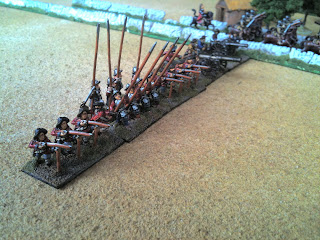In late summer 1643, a sizeable force of Sir Ralph Hopton's army surprise Waller's Parliamentarians near a hamlet in Somerset. The Royalists quickly deploy their mounted troops to the open ground on their right wing hoping to strike while Waller's foot struggle out of ground domindated by hedges. Knowing his foot is outnumbered in the centre but certain that his left flank is securely pinned on the hamlet where his dragoons lurk, the Royalist commander quickly takes the initiative on the right and charges the Parliamentarian artillery.
 |
| View from the Royalist rear - the cavaliers charge on the right is countered by Parliament's heavy cuirassiers |
The Parliamentarian commander, seeking to buy some time while his remaining shotte deploy to reinforce his beleaguered left, leads his heavy cuirassiers in a daring charge to break the Royalist foot that have rushed in to support the cavaliers. The cavaliers try to ride down the exposed Parliamentarian left but the momentum of their charge is broken at cannon's mouth. In the centre the Royalist foot deploy their pike in depth, and the musketeers steady themselves for the maelstrom of lead that will issue from the cuirassiers wheellocks as they smash into their ranks.
 |
| The cavaliers falter as the Parliamentarian heavy cavalry countercharge |
The failure of the cavaliers to drive their charge home, coupled with the heavy losses among the Royalist mounted troops from cannon and musket fire, gives the Parliamentarian shotte time to deploy. Encouraged by the arrival of the foot, the horse teams are whipped into the melee and manage to draw the heavy guns back out of danger. But, the undaunted cavaliers wheel around and slam into the flank of the muskets forcing them to turn to meet the charge. The din of battle soars as the 'lobsters' drive into the Royalist foot decimating the front ranks of pike and musket, driving all before them with their commander at the very apex of the charge. Yet, seemingly out of nowhere, remnants of the Royalist mountet troops slam into the left flank of the cuirassiers - both commanders sense the moment of decision has come. Who will carry the day?
 |
The high water mark - remnants of the first Royalist charge strike the exposed left of the
Parliamentarians while the cavalry reserve charges to support them. |
Battle rages ... the smoke of musketry blinds those engaged ... the commanders rise in their saddles ... the gods of war roll their dice ...
 |
| Bella detesta matribus! (Horace) |
Wars, the horror of mothers! The lobsters shrug off the challenge to their flank and decimate the Royalist centre. While in the distance, the hard-pressed Parliamentarian musketeers are savaged by the impetuous charge of the few remaining cavaliers, the remaining foot flee. The Royalist commander rushes to plug the gap in his line ... but the day is lost (4:1).
 |
| The Royalist heavy cavalry arrive too late. |



















